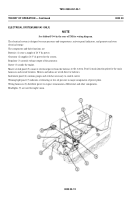TM-9-2350-261-20-1 - Page 78 of 346
TM 9-2350-261-20-1
THEORY OF OPERATION — Continued
0003 00
AUXILIARY AUTOMOTIVE SYSTEM
The auxiliary automotive system includes driver controls, personnel heater, bilge pumps, crew ventilation system, and fire
suppression system.
Driver Controls
The driver controls regulate the engine, transmission, and steering braking systems of the carrier.
The fuel shutoff control is used to stop the supply of fuel to the engine injectors. To start the engine, the driver must push
in the fuel shutoff control. The throttle linkages are used to control the engine speed. The gear selector allows the driver to
choose the proper gear for the carrier. The steering and braking levers control separate right and left steering brakes in the
control differential. By pulling on the levers, you can slow or stop either track for steering, or both tracks at once for stopping.
A lock button at the top of each lever lets you set and lock the brakes for parking.
Pivot Steering And Brakes
Pivot steer brakes are disk brakes and work like the differential brakes, but quicker.
Personnel Heater
NOTE
New style heater MODEL A-20 needs to have the power cable removed before any welding is
performed on the hull. If left connected, a circuit card in the heater will be damaged by MIG or
TIG welding.
The personnel heater system provides heat inside the carrier. Major parts are the combination combustion chamber/heat
exchanger, blowers, a fuel pump, fuel filter, and an electrical control. The heater operates using diesel fuel pumped from the
fuel tanks. Fuel goes through fuel filter and is then delivered to the combustion chamber from the fuel pump. Outside air is
drawn into the combustion chamber by one of the blowers. A blower draws air from the crew compartment into the heater
exchanger. The air is warmed by heat created by the combustion process and then returned to the crew compartment.
Bilge Pumps
Two electrically-driven bilge pumps remove water and other liquids from the hull. Water enters the pumps through a screened
inlet. The pumps force water out of the carrier through outlet tubes. The bilge pumps are controlled by a switch on the
driver’s instrument panel.
Fire Extinguisher System
The fire extinguisher system consists of two CO2 (carbon dioxide) cylinders, one fixed and one portable. Carbon dioxide
puts out fires quickly and effectively. The fixed cylinder is located near the driver’s compartment and is operated manually
by pulling cables located on top of carrier next to driver’s hatch. The fixed cylinder releases CO2 in the power plant
compartment only. The portable fire extinguisher is located in the crew compartment and is manually discharged.
HYDRAULIC SYSTEM
The ramp is raised or lowered by a hydraulic system which consists of a pump, a cylinder, a control valve, and a hydraulic
tank. This system is controlled by a three-position valve located near the driver. Moving the valve to the RAISE position
directs fluid to the ramp cylinder. Moving the valve to the LOWER position allows the gravity of the ramp to return hydraulic
fluid to the reservoir. There is a breather hose on the ramp cylinder to allow the cylinder to breathe air. The hose is connected
to the rear bilge pump tube outlet to prevent water in the lower hull from getting into the ramp cylinder and causing it to
corrode.
000300-3
Back to Top




















